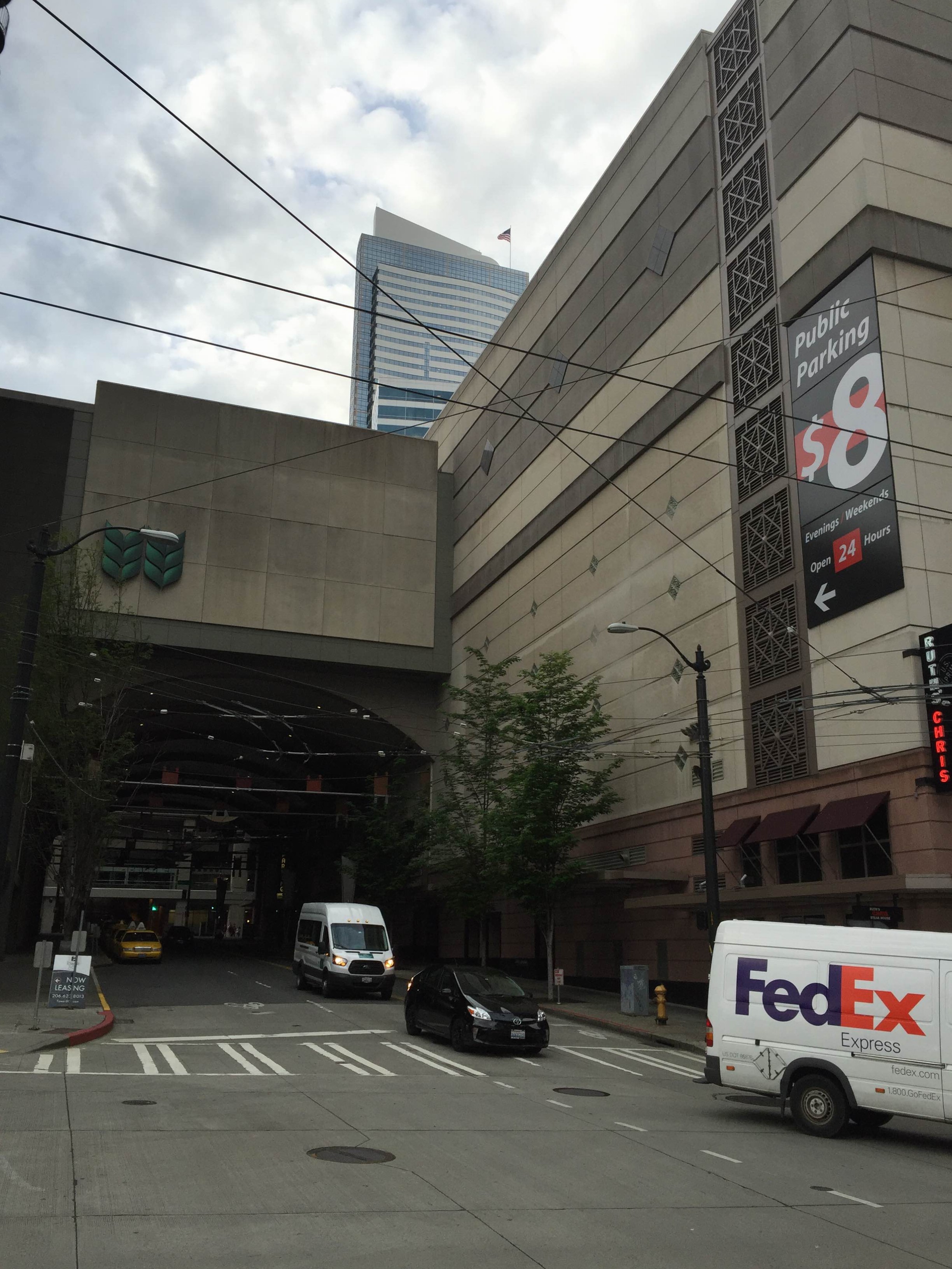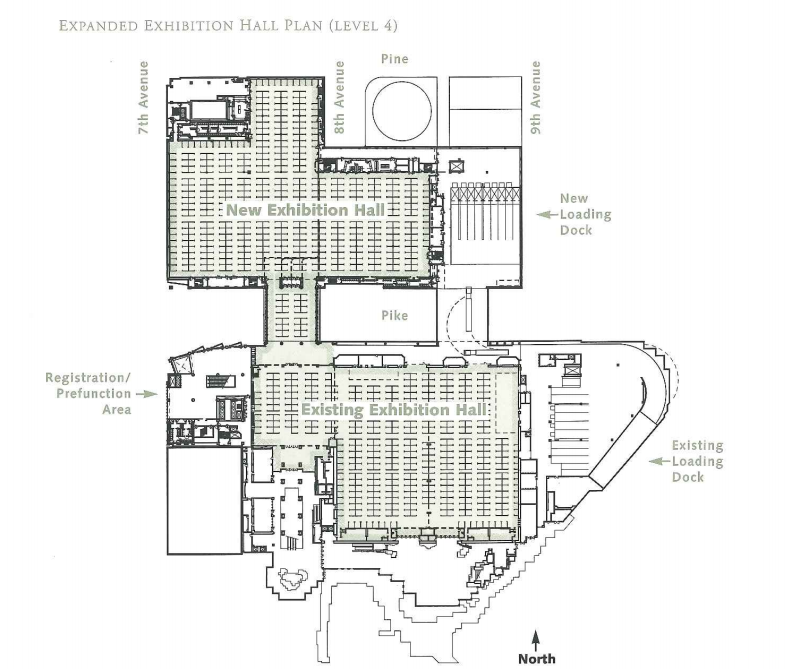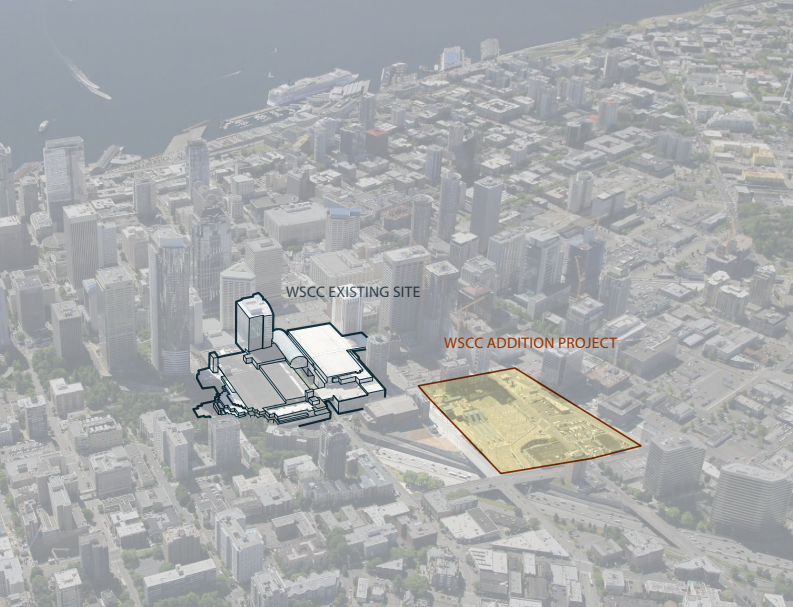The City of Seattle and the Puget Sound region are growing rapidly. As a result, residents are facing huge spikes in housing costs, overburdened transportation infrastructure, and a shortage of space for everything from schools and parks to artist studios and small businesses. Residents have cried out for more of all of these things, but currently working through the design and entitlement pipeline is a multi-block, $1.4 billion dollar expansion of the Washington State Convention Center (WSCC) that city residents have not asked for, and likely would not vote for. The WSCC has claimed that the expansion is needed for the facility to remain competitive in its national marketplace, and the expansion will allow for larger and more frequent events.
According to the WSCC, these events will draw more visitors to Seattle, boosting tourism spending on hotel rooms, rental cars, bars, restaurants and shopping. The WSCC has claimed that it has been turning away large events due to lack of available space, and this expansion is needed to meet that demand, but previous expansions by the WSCC based on similar claims have failed to attract more visitors to Seattle, and failed to bring the expected economic benefits with them. The WSCC and the City of Seattle could learn from the mistakes of past convention center expansions in Seattle and elsewhere and consider alternatives to this expensive and ineffective economic development tool. The development opportunities on the four-block, publicly owned site are enormous, but what gets built deserves to be entirely in the public interest.
The WSCC is a public facilities district (PFD) that has its own bonding authority, with municipal bonds being the funding mechanism for this proposed expansion. Those municipal bonds are backed through the local hotel tax, which diverts 7% of room rental revenue directly to the WSCC. Despite the use of public funds for this project, there has been no referendum on whether or not the residents of Seattle want this expansion. Publicly funded projects like schools, transportation, housing, and fire stations routinely undergo rigorous public debate and ballot referenda to approve their funding, but the WSCC, a special district, has not faced the same scrutiny for its expansion despite the staggering price tag.
To Expand Or Not To Expand?
The WSCC’s justification for the expansion comes primarily from a 2014 market feasibility study produced by Convention Sports and Leisure (CSL), one of a handful of consulting agencies that advises cities on whether they should build or expand their convention facilities, typically after there is already a plan to do so. Their answer to Seattle and the WSCC, as has been their answer to almost every city in the county, was an emphatic yes. Their reasoning was based on surveys of event planners, and statistical analysis of recent national trends in the convention business. Their analysis, however, did not examine the expansion of the WSCC over the past two decades and expansion’s effect on attendance, the major driver of economic benefit.

In the mid-1990’s, Seattle was considering an expansion of the facility that originally opened in 1988, spanning over I-5 in downtown Seattle. The new facility, (much like the current expansion project) would double the size of the existing facilities, and the projected growth in attendance was expected to provide a huge economic benefit to Seattle. At the time, convention centers across the country had seen steady growth since the mid 20th century. However, according to a 2005 Brookings Institute report, starting in the 1990’s, national convention attendance flatlined. Additionally, numerous, major obstacles to future growth surfaced. The September 11th terrorist attacks stifled air travel. The 2008 economic meltdown left little money for business travel. Even before the 2001 expansion broke ground, the Internet had already started to make travel for many previously necessary reasons, like convention attendance, obsolete. As information is more easily presented to large audiences through improved, digital communication methods, the need to physically collect people in one place became less necessary for that information to be shared.
The WSCC probably could not have predicted these external factors when planning the expansion that opened (very unfortunately) in 2001, but it can learn from the experience. According to The Seattle Times in 2009 when the WSCC was initially proposing its current expansion project:
In the three years before construction on that project [the 2001 expansion] began, the convention center averaged 440,000 visitors a year, according to WSCTC annual reports. Between 2005 and 2007 (the last year for which statistics are available), it averaged 430,000. The same trend holds true for out-of-state convention-goers — the WSCTC’s main target.
Since The Seattle Times report in 2009, the situation has worsened for the WSCC. Reports from the past few years indicate annual attendance hovering around 425,000 per year, but out of state visitors have plummeted from over 180,000 per year before the expansion to just 126,000 in 2014. The same arguments of lack of space and outdated facilities were made for the 2001 expansion, and the 15-year return on that massive investment has been distinctly negative. While the WSCC may be facing demand to host more events, the economic benefits of those events are tied to the people that travel to attend them, and for the past 20 years, those visitors have not been showing up to the WSCC like they used to.
While CSL indicates in their report that there has been a modest post-recession recovery in the past few years, those modest year-to-year gains gloss over the major losses sustained in 2008 and 2001, and the longer arc of history in the industry.
The CSL market analysis provided for the WSCC shows that the biggest contributor to attendance now comes from consumer shows and public events, like wedding expos, and weekend events for specific interest groups like comic books, anime and video games, not major national conventions of trade groups and professional organizations.
Although they comprise a relatively small portion of facility utilization days, consumer shows and public events make up the largest portion of WSCC attendance each year (ranging from 141,000 to 165,000). – CSL report p11
In 2014, the reported attendance of Sakura-con and Emerald City ComicCon combined for over 93,000 attendees. These events lasted for a total of just six days over two weekends, but comprised about 20% of the entire yearly attendance at the WSCC. These types of shows, by their nature, draw a more local audience who are not filling hotel rooms for weeks at a time, and are generally not using their corporate expense accounts to network over cocktails and steak dinners. They are a local and regional audience, traveling short distances in large numbers over weekends. On a few occasions per year, the cavernous spaces of the WSCC are filled with huge crowds that test the limits of the regional transportation infrastructure, but on most days, the WSCC, and the surrounding few blocks are deserted.
Ironically, even without this proposed expansion, the City of Seattle and the Puget Sound region are achieving the goals of increased travel and tourism that the WSCC set forth. Even with dwindling out of state attendance at the WSCC, in 2014, Seattle achieved a record 82.2% hotel occupancy, and security lines at Sea-Tac International Airport are consistently wrapping around the terminal. This growth in travel to the city can be attributed to the general health of the business and tourism economies in Seattle. While it may not have been true in the 1980’s when the convention center first opened, downtown Seattle is booming, not because of the convention center, but in spite of it.
Convention Center Building Continues Despite Lack Of Need
While national trends indicate flat attendance numbers since the mid-1990’s, the convention center building boom has been going strong nationwide for over 20 years. From 1989 to 2011, the amount of available convention exhibit space in the United States nearly doubled from 36 million to 70.5 million square feet, and the boom shows no sign of slowing, with Seattle as a prime case study. Prior to the 2001 expansion, the WSCC had a pretty good idea of why the building boom was occurring. In 1996, then director of the Washington State Convention and Trade Center, John Christison was quoted in the trade publication Amusement Business as the WSCC was planning to expand from 155,000 square feet to 258,000 square feet:
I think some cities make decisions based on civic pride. If San Diego has 350,000 square feet, by God, we’ll have 450,000…. …To go any bigger [than 258,000 square feet], we might be keeping up with the Joneses, but we wouldn’t necessarily be making any more money…..If you look at the marketplace, and you think of it as a triangle, the majority of the business requires less than 100,000 square feet of exhibit space. That’s the bottom of the triangle, which is wider and deeper than the top.
This glut in available space has created the competitive market in which the WSCC finds itself, but the current expansion proposal only offers more of the same enormous exhibit and ballroom space that has been overbuilt for the past 20 years.
Christison’s successor at the WSCC may have different opinions on the benefits of expansion. Prior to joining the WSCC 2011, Jeffrey Blosser, current President and CEO, served as the director of the Oregon Convention Center (OCC) in Portland beginning in 1989. During that time, the OCC also undertook a massive expansion that opened in 2003. In 1997, Blosser argued that the center “is running essentially at capacity,” (the same argument Blosser and the WSCC are making now) and requested the OCC grow from 150,000 square feet to 250,000. Voters in Portland overwhelmingly disapproved of the original tax plan to finance the expansion, but funding was eventually secured through bonds backed by higher hotel and car rental taxes. The results of the expansion were a huge disappointment. In an article titled, “The Answer is Always Yes,” describing the cozy relationship between consulting firms and the convention centers that hire them, Forbes magazine described the situation in 2005:
By the end of 2004 the center’s finances were in bad shape. To get 34 decent-size shows, the center had to indirectly waive rental fees for the organizers of 10 of them. The building would have lost $15,000 a day if not for $6 million in tax subsidies. Hotels are 60% occupied, as fewer than 30% of convention-goers last year came from outside Portland.

Seattle’s situation is even worse. Currently, the WSCC pays over $16 million per year in debt service, primarily to pay off the 2001 expansion. Annual building rent revenue, however, comes in at only $4.6 million, and without the approximately $65 million in tax revenue, in 2014, the WSCC would have lost about $30 million, over $80,000 per day. Prior to the formation of the WSCC public facilities district (PFD) in 2011, the Washington State Convention and Trade Center (WSCTC) operated as a public, non-profit organization, where excess hotel tax revenue was given to the Washington State general fund. Since the formation of the PFD, however, the WSCC keeps the excess tax revenue allowing it to appear that it is operating at a profit, when in reality, it operates on a very generous public subsidy.
Seattle’s experience is similar to many cities across the country. In his recent book, Convention Center Follies, Heywood Sanders, Professor of Public Administration at the University of Texas, San Antonio, describes, in meticulous detail, the consultants like CSL that encourage expansion, the patterns of failed development that convention facilities across the country have followed, and the political approvals that are often heavily obscured to the public. The Pennsylvania Convention Center in Philadelphia opened a $786 million expansion in 2011 relying in part on a feasibility report supplied by CSL. The reality of hotel room-night generation (a measure of the impact of out of town visitors) after the expansion barely exceeded 50% of the forecast CSL had made while recommending the larger facility. In 2012, after the expansion opened, hotel room-nights generated by convention attendance were even lower than before the expansion. Sanders describes the process:
Those ‘expert’ studies admitted no uncertainty about larger market realities or future performance. It was simply taken as a given that the new center would produce the anticipated benefits. And when the expansion proposal was developed, that discussion too was suffused with consultant predictions of an economic boom, with no real effort on the part of local officials, city and state bureaucrats, or news media to determine whether earlier forecasts had really been met.
Seattle Can Do Better Than Just An Expansion
Each city that has taken on a major expansion has believed that their city is distinct and special, and conventions would flock to them because of that. Their civic pride was backed up by analysis by firms like CSL telling them that if they built more, attendees would come in droves. Seattle is no different in this regard. CSL was paid to provide a report encouraging convention center expansion, but the residents of Seattle do not have to accept their findings as the only way to improve this part of our city. In fact, Seattle is already a delightful city. The city has gorgeous views of mountain ranges, Puget Sound, and the many lakes in the area. It has thriving businesses of all scales, and amazing local food and products sold in a variety of unique markets. These are the reasons people travel here. They travel here to get out, interact with and enjoy what this city has to offer. They are not coming to sit in an ever-expanding convention center, nearly identical to facilities in any other major city.
The existing WSCC facilities are enormous for their urban context, and through their voracious appetite for street and alley vacations, they have created some of the worst urban spaces in Downtown Seattle. The current WSCC acts as an obstacle rather than an amenity to urban life. Repeating the expansion mistakes from past decades will only result in more blank facades with loading docks, parking entrances, and acres of empty lobby facing major pedestrian streets. The money currently being poured into this expansion proposal would be well spent adapting the current facility into a space that both accommodates conventions and fixes the massive urban design mistakes that have trashed this part of Downtown. The four-block expansion site would then be available to create a true amenity to the city, one that is created for public use by Seattle residents, rather than an empty facility dedicated to occasional use by visitors.
While Seattle residents may not directly feel the tax burden of financing the WSCC, the city will live with the development ramifications of this proposed expansion for generations. Referenda come on every ballot for sums that pale in comparison to this proposal. Those ballot propositions are for projects like fire stations, schools, parks, affordable housing and transportation, yet the decision to expand the WSCC has been absent in the public sphere. The direction of this project and its enormous budget should not be decided by consulting firms with dubious track records who have been paid to determine a specific outcome. The national convention marketplace has changed dramatically in the past 20 years, and the WSCC needs to address that fact. Enormous exhibit halls and ball rooms may have made sense in the 1990’s, but attendance numbers show that even with more space, the expected visitors will not be coming like they used to. The use of this enormous, publicly owned property must come from the desires and the needs of the public, after spirited discussion to determine its best use, and $1.4 billion dollars of public money can do much more to benefit the City of Seattle than what the WSCC is proposing.
David Dahl is an award-winning architectural and urban designer in Seattle, Washington.



